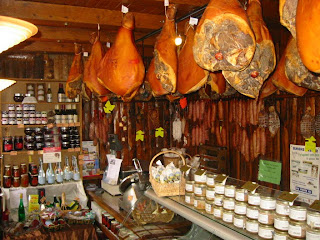 Charcuterie is the branch of cooking devoted to prepared meat products such as bacon, ham, sausage, terrines, galantines, pâtés, and confit, primarily from pork. Charcuterie is part of the garde manger chef's repertoire. Originally intended as a way to preserve meats before the advent of refrigeration, they are prepared today for their flavors derived from the preservation processes.
Charcuterie is the branch of cooking devoted to prepared meat products such as bacon, ham, sausage, terrines, galantines, pâtés, and confit, primarily from pork. Charcuterie is part of the garde manger chef's repertoire. Originally intended as a way to preserve meats before the advent of refrigeration, they are prepared today for their flavors derived from the preservation processes.The Romans may be the first to have regulated the trade of charcuterie as they wrote laws regulating the proper production of pork joints; it was the French though, who raised the skill to an art. In 15th century France local guilds regulated tradesmen in the food production industry in each city. The guilds that produced charcuterie were those of the charcutiers. The members of this guild produced a traditional range of cooked or salted and dried meats, which varied, sometimes distinctively, from region to region. The only "raw" meat the charcutiers were allowed to sell was unrendered lard. The charcutier prepared numerous items including pâtés, rillettes, sausages, bacon, trotters, and head cheese. These preservation methods ensured that meats would have a longer shelf-life.
The French word for a person who prepares charcuterie is charcutier, generally translated into English as "pork butcher." This has led to the mistaken belief that charcuterie can only involve pork. The Food Lover's Companion, however, says that "it refers to the products, particularly (but not limited to) pork specialties such as pâtés, rillettes, galantines, crépinettes, etc., which are made and sold in a delicatessen-style shop, also called a charcuterie." And the 1961 edition of Larousse Gastronomique defines it as: "The art of preparing various meats, in particular pork, in order to present them in the most diverse ways."



No comments:
Post a Comment